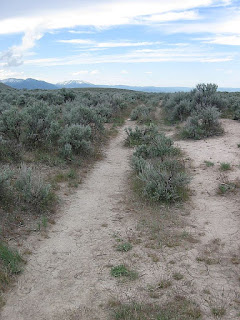 |
| A diorama at the Oregon Trail Interpretive Center. |
We've spent the last couple of weeks watching
Wagon Train, a popular Western that aired for 276 episodes starting in 1957, on DVD. When I was growing up, it was must-see TV for me.
Even in grade school, I had an interest in the pioneers who crossed the United States to find a new life in Oregon, California and Washington.
I can still remember a couple of great-aunts talking about their grandfather (my great-great-grandfather) who left France to build a new life in the American West, crossing first the Atlantic Ocean by boat and then this country by wagon train. My aunts used to talk about how his wagon train was attacked by Indians on the trip, but didn't find it ironic that when he arrived in Washington Territory he married a woman who was the daughter of a French-Canadian fur trapper and a Chinook Indian woman. No one seems to know when he crossed the country, only that he was married in Astoria, Oregon, in the spring of 1863.
Many years ago, I drove sections of the Oregon Trail through Wyoming and marveled how it only took me 15 minutes to drive as far as the pioneers did in one day. I remember stopping at Guernsey, Wyoming, where, more than 100 years later, deep wagon wheel ruts still existed.
Closer to home, the wagon trail is still visible at the Whitman Mission in Walla Walla, Washington, and the Oregon Trail Interpretive Center at Baker City, Oregon. If you're ever driving Interstate 84 through eastern Oregon, definitely make time for a stop at the interpretive center. The center sits on Flagstaff Hill about five miles off the freeway. Paved trails lead downhill to the ruts, although you can also see ruts a short distance from the road at the bottom of the hill.
 |
| Wagon wheel ruts in Oregon |
The center has excellent dioramas that are so realistic you'd swear you were on the trail with the pioneers, who were dirty and dusty from the trail. Not at all like the pioneers on
Wagon Train who frequently wore suits and ties or, if they were women, snowy white blouses. The wagons on the television show were large and roomy, but the wagons on display at the center are narrow and difficult to move around upright for adults inside.
The center also puts on interpretive programs on various facets of life along the trail. These, too, are well worth attending if one is taking place during your visit. One program that I attended featured one woman portraying four women in different stages of their lives and journeys over the Oregon Trail. The actress was so realistic in her portrayals she had the audience in tears by the end of the hour.


